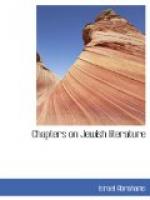The link between Immanuel and his Provencal contemporary Kalonymos was supplied by Judah Romano, the Jewish school-man. All three were in the service of the king of Naples. Kalonymos was the equal of Romano as a philosopher and not much below Immanuel as a satirist. He was a more fertile poet than Immanuel, for, while Immanuel remained the sole representative of his manner, Kalonymos gave birth to a whole school of imitators. Kalonymos wrote many translations, of Galen, Averroes, Aristotle, al-Farabi, Ptolemy, and Archimedes. But it was his keen wit more than his learning that made him popular in Rome, and impelled the Jews of that city, headed by Immanuel, to persuade Kalonymos to settle permanently in Italy. Kalonymos’ two satirical poems were called “The Touchstone” (Eben Bochan) and “The Purim Tractate.” These satirize the customs and social habits of the Jews of his day in a bright and powerful style. In his Purim Tractate, Kalonymos parodies the style, logic, and phraseology of the Talmud, and his work was the forerunner of a host of similar parodies.
There were many Italian writers of Piyutim, i.e. Synagogue hymns, but these were mediocre in merit. The elegies written in lament for the burning of the Law and the martyrdoms endured in various parts of Italy were the only meritorious devotional poems composed in Hebrew in that country. Italy remained famous in Hebrew poetry for secular, not for religious compositions. In the fifteenth century Moses Rieti (born 1389, died later than 1452) imitated Dante once more in his “Lesser Sanctuary” (Mikdash Meaet). Here again may be noticed a feature peculiar to Italian Hebrew poetry. Rieti uses regular stanzas, Italian forms of verse, in this matter following the example of Immanuel. Messer Leon, a physician of Mantua, wrote a treatise on Biblical rhetoric (1480). Again, the only important writer of dramas in Hebrew was, as we shall see, an Italian Jew, who copied Italian models. Though, therefore, the Hebrew poetry of Italy scarcely reaches the front rank, it is historically of first-rate importance. It represents the only effects of the Renaissance on Jewish literature. In other countries, the condition of the Jews was such that they were shut off from external influences. Their literature suffered as their lives did from imprisonment within the Ghettos, which were erected both by the Jews themselves and by the governments of Europe.
BIBLIOGRAPHY
S. Morals.—Italian Jewish Literature
(Publications of the
Gratz College, Vol. 1).
IMMANUEL AND KALONYMOS.
Graetz.—IV, p. 61 [66].
J. Chotzner.—Immanuel di Romi, J.Q.R., IV, p. 64.
G. Sacerdote.—Emanuele da Roma’s
Ninth Mehabbereth,
J.Q.R., VII, p. 711.
JUDAH (LEONE) ROMANO.
Graetz.—IV, p. 68 [73].




